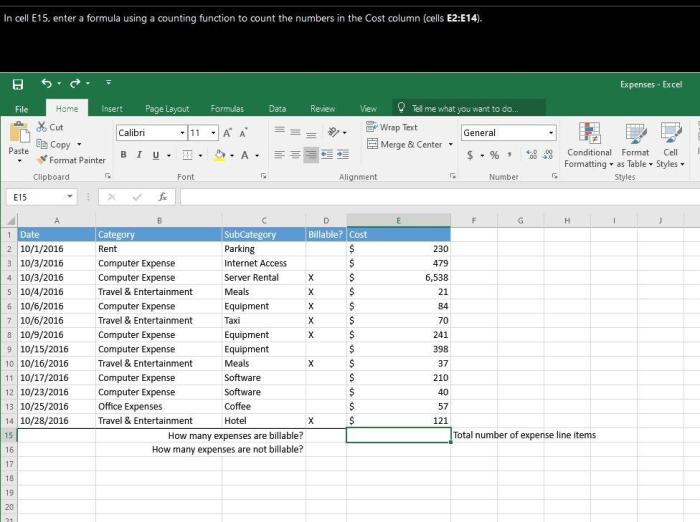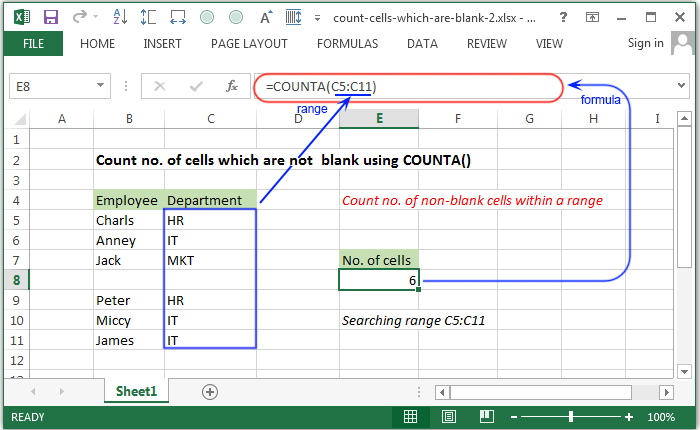In cell d15 enter a formula using a counting function – In the realm of data analysis, the COUNT function stands as an indispensable tool, empowering users to efficiently enumerate cells meeting specific criteria. This comprehensive guide delves into the intricacies of using a counting function in cell D15, providing a step-by-step approach and illuminating the nuances of data preparation and troubleshooting.
Beyond the fundamentals, we explore advanced applications of the COUNT function, unlocking its potential for counting unique values, applying criteria, and harmonizing with other functions. Embark on this journey to elevate your data analysis prowess and unlock the power of the COUNT function.
Counting Function Basics: In Cell D15 Enter A Formula Using A Counting Function

Counting functions in Excel are used to count the number of cells that meet specific criteria. The most basic counting function is the COUNT function, which counts the number of cells that contain any value, including empty cells.
Other counting functions include:
- COUNTA: Counts the number of cells that contain any value, excluding empty cells.
- COUNTBLANK: Counts the number of empty cells.
- COUNTIF: Counts the number of cells that meet a specific criterion.
- COUNTIFS: Counts the number of cells that meet multiple criteria.
The syntax of the COUNT function is as follows:
=COUNT(range)
where “range” is the range of cells that you want to count.
Using COUNT in Cell D15

In cell D15, we want to count the number of cells in the range A1:A10 that contain a value greater than 5.
To do this, we can use the following formula:
=COUNTIF(A1:A10,”>5″)
This formula will count the number of cells in the range A1:A10 that contain a value greater than 5 and return the result in cell D15.
Data Preparation for COUNT Function
Before using the COUNT function, it is important to prepare your data so that the results are accurate.
Here are some tips for preparing your data:
- Clean your data: Remove any unnecessary spaces, special characters, or other formatting that could interfere with the COUNT function.
- Organize your data: Make sure that your data is organized in a way that makes it easy to count the cells that you want to count.
- Handle empty cells: Decide how you want to handle empty cells. You can either include them in the count or exclude them.
- Handle errors: Make sure that there are no errors in your data. Errors can cause the COUNT function to return incorrect results.
Troubleshooting COUNT Function Errors

If you are getting errors when using the COUNT function, there are a few things that you can check:
- Make sure that the range that you are counting is correct.
- Make sure that the criteria that you are using is correct.
- Make sure that there are no errors in your data.
- You can use the ISERROR function to check for errors.
Advanced COUNT Function Applications
The COUNT function can be used for a variety of advanced applications, such as:
- Counting unique values: You can use the COUNTIF function to count the number of unique values in a range of cells.
- Counting by criteria: You can use the COUNTIF function to count the number of cells that meet a specific criterion.
- Using the COUNT function in combination with other functions: You can use the COUNT function in combination with other functions to perform more complex calculations.
Question & Answer Hub
What is the syntax of the COUNT function?
The syntax of the COUNT function is COUNT(range), where range represents the cells to be counted.
How can I count cells that meet specific criteria?
To count cells that meet specific criteria, use the COUNTIF function. The syntax is COUNTIF(range, criteria), where range represents the cells to be counted and criteria specifies the condition.
What is the difference between COUNT and COUNTA?
COUNT counts only non-empty cells, while COUNTA counts all cells, including empty cells.